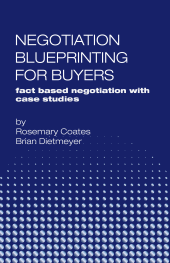 At the negotiating table, the pressure we feel from commoditization is both common and pervasive. It can often be crippling because it limits our options. You think less clearly and have a harder time focusing on your goals. As a result, bad decisions are made – based on temporary conditions – that last, in some cases, forever. Commoditization pressure is just another tactic a buyer uses to back you into a corner so that lowest price becomes the issue rather than quality, customer service, your ability to solve their business problems, a feature they might actually value or a dozen other valuable things you may have to offer. They do this because it works; we feel the pressure and begin to react defensively.
At the negotiating table, the pressure we feel from commoditization is both common and pervasive. It can often be crippling because it limits our options. You think less clearly and have a harder time focusing on your goals. As a result, bad decisions are made – based on temporary conditions – that last, in some cases, forever. Commoditization pressure is just another tactic a buyer uses to back you into a corner so that lowest price becomes the issue rather than quality, customer service, your ability to solve their business problems, a feature they might actually value or a dozen other valuable things you may have to offer. They do this because it works; we feel the pressure and begin to react defensively.
Are You Really Selling a Commodity?
To determine if you are selling a true commodity, ask yourself these two questions:
-
Does anyone in your field have a price premium?
-
Does the lowest-priced provider have 100% share?
If you answer the first question “yes” and the second “no,” then you are not selling a commodity.
As a refresher, commoditization means that everything being sold is essentially the same (at least from the buyer’s perspective). You and your competitors are offering the same thing: the same types of technology, the same types of e-learning products, the same types of running shoes, etc. This doesn’t mean you don’t make the best darn running shoes in the universe, but from a buyer’s perspective it’s just another running shoe, so why should yours cost more?
The short answer, from your perspective, is that your running shoe is just like a Ferrari. Technically speaking, a Ferrari is just a car. But would a sane person walk into a Ferrari dealership and balk at the sticker price? Hardly. He knows he’ll get more than just a car; he’ll get state-of-the art engine technology, cutting-edge comfort, blistering style, out-of-this world performance and an incredible rush just hearing the engine roar to life. He wouldn’t dream of comparing the price of that Ferrari to the price of a Ford Escort, would you? Of course not, because even though the Ferrari is a car, you know it’s not a commodity. Yet, in the situation we sellers often face, our buyers approach the negotiation table as if our product is a commodity.
Consequences of no agreement (CNA) analysis will give you the skills you need to neutralize commoditization pressure by quantifying what you have that others don’t have that is actually valuable to a customer, and leveraging that value to your negotiating advantage. You must be able to articulate value; it’s the only thing that will take the pressure off of price and keep the deal from being reduced to a price war over a commodity product or service.
Viewing supplier companies side-by-side, to see which provides better wrap-around services and support, etc., often reveals a differential that clearly separates the product offerings. Value, then, must be mapped against this customer’s needs and viewed from the perspective of the total ecosystem. Now, if you look at the total relationship between your firm and your customer and it is, in fact, exactly the same as your competitor’s relationship, then you don’t have a negotiation problem, you have a non-existent value proposition.
For now, we will assume there is some value in what you offer, whether that value is inherent in the product features or design, the ecosystem your company can offer (services, support, delivery times, etc.) or the relationship you bring to the table.
The bottom line? Expect buyers to attempt to commoditize; it’s what they’re paid to do. And it’s your job to combat commoditization at all costs.





